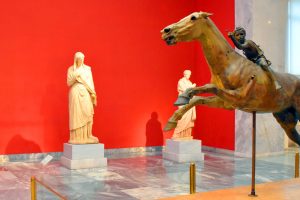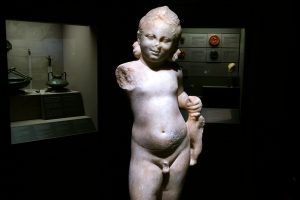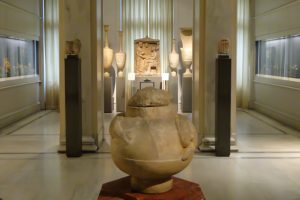The Acropolis Museum is consistently rated as one of the best museums in the world. Devoted to the Parthenon and its surrounding temples, it is cleverly perched above Athens like a luminous box. The large glass panes beautifully draw in the ancient and modern parts of the city, making it a truly evocative experience. Designed by New York’s, Bernard Tschumi, with local Greek architect Michael Photiadis, it is the perfect sanctuary for the ancient artefacts that were found in and around the Acropolis and successfully deconstructs how the Parthenon sculptures once looked to the citizens of ancient Athens.
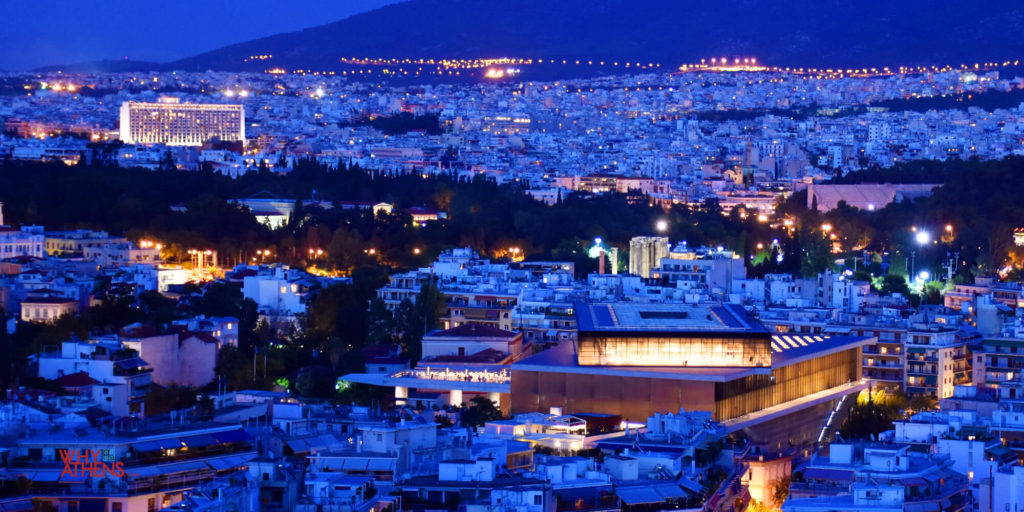
The glow of the Acropolis Museum at night against the Athenian cityscape. Photograph: Why Athens.
Skip the line e-tickets are available to purchase here in advance
Located in the central neighbourhood of Makrigianni, the museum is framed by olive trees and propped up by concrete pillars, revealing the site’s archaeological excavation below. The remnants are of an ancient neighbourhood that once thrived, complete with a drainage system, bathhouses and mosaics.
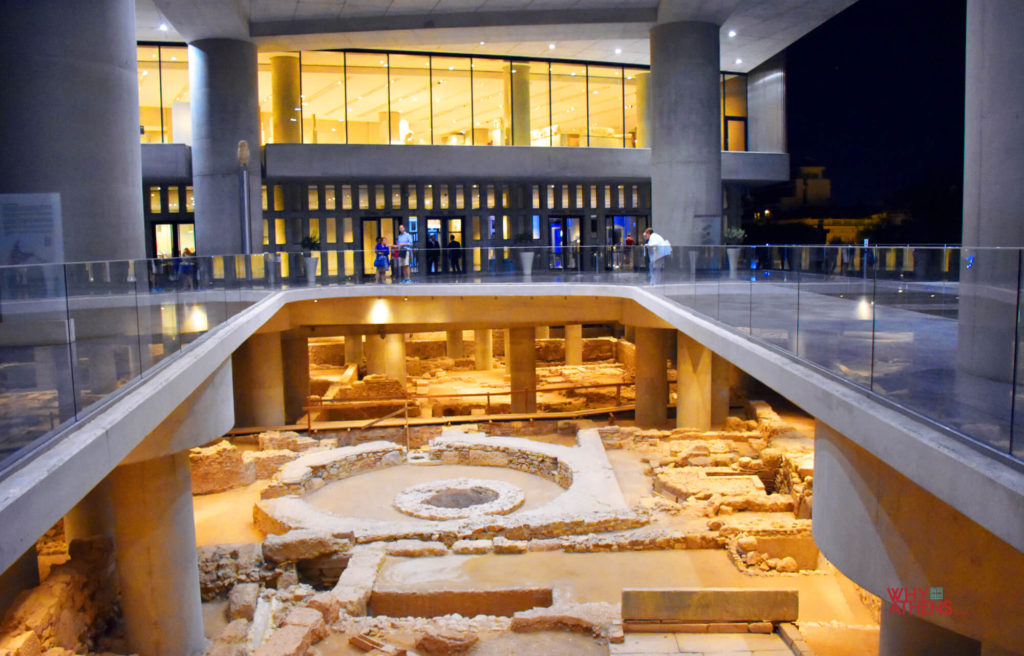
The remnants of an ancient city at the entrance of the museum. Photograph: Why Athens | Acropolis Museum
Having visited the museum on numerous occasions, we suggest starting your journey from the top floor of the ‘Parthenon Gallery’ and making your way down from here. Acropolis Museum literature also supports this and it will tell a much more coherent story and will also prevent you from cutting short what is the absolute highlight of the museum. From this third floor, you will not only be mesmerised by the magical views, but will also get to appreciate the amount of thought the architects have placed into the museum’s design. The glass panelling and elevation of this floor allows you to easily glance over to the ancient city of the Acropolis, with the Parthenon always in plain sight only 300 metres away. So after purchasing your tickets, do yourself a favour, hop in the lift and go directly to level three.
The Parthenon Gallery, level 3 of the Acropolis Museum
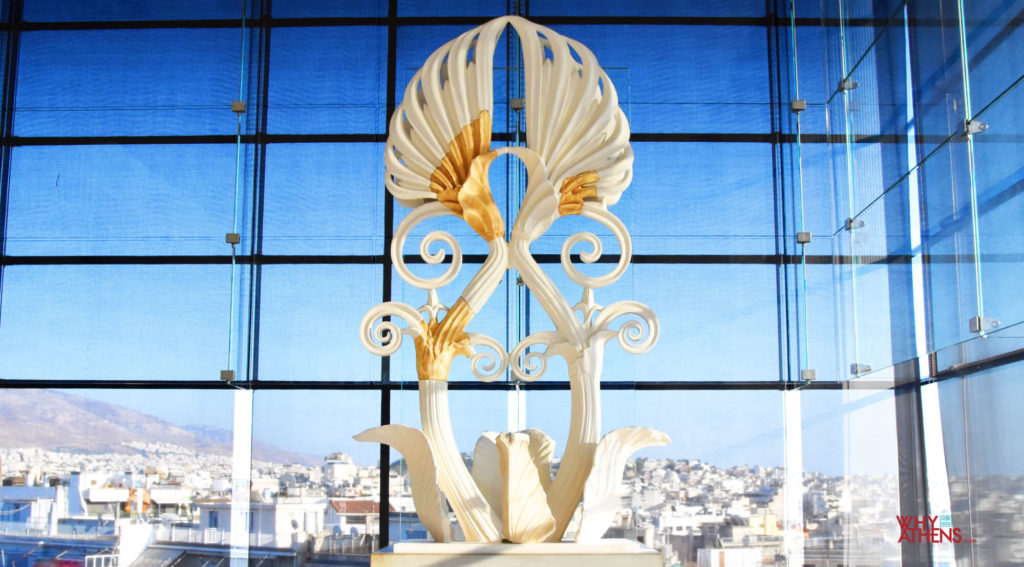
A reconstruction from both original and plaster pieces of the floral ‘Akroterion’ which crowned the top of the east pediment measuring 4 metres high. Photograph: Why Athens | Acropolis Museum
The top floor of the museum is designed on the same axis as the Parthenon so that it has the identical cardinal orientation. Additionally, it has the same dimensions to display the entire frieze of the temple, exactly as it would have been in ancient times. As you make your way around, it’s as if you are walking around the core or “cella” of the Parthenon. The three basic sculptural components of the Parthenon are; the pediments (east and west), the metopes and the frieze.
The following image shows what the Parthenon would have looked like in ancient times complete with coloured motifs. A reconstruction of the Parthenon was erected in 1897 in Nashville, Tennessee, and stands to this day as the closest example of what the Parthenon would have looked like.
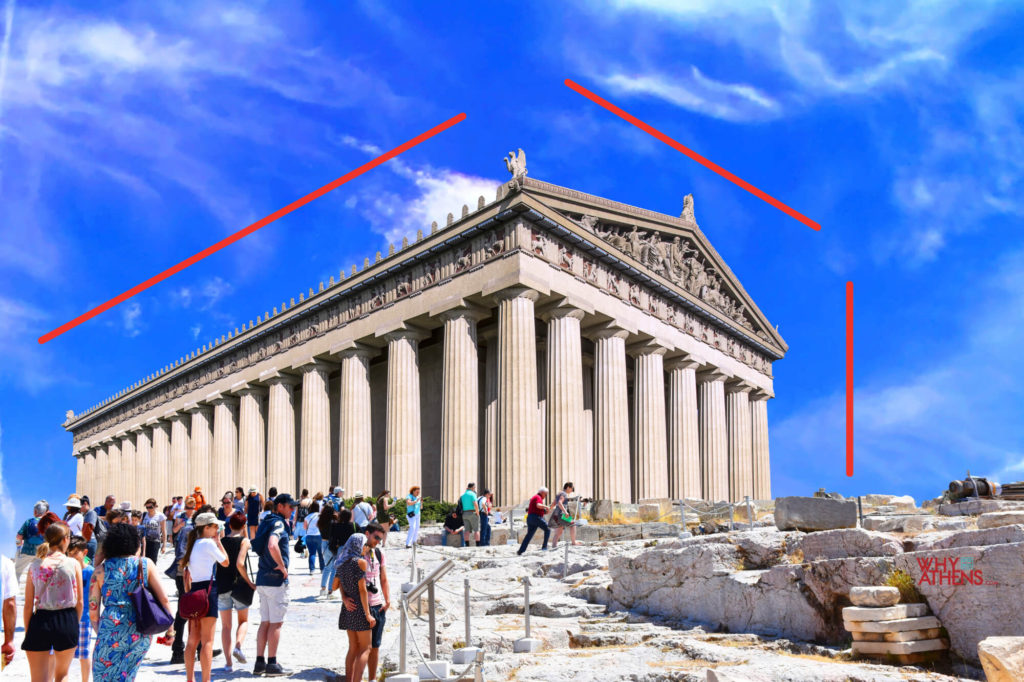
Helpful background: An extensive building program was commissioned by the famous politician Pericles. The Parthenon was built between 447 and 438 BC by architects Iktinos and Kallikrates. Works commenced in mid 5th century BC and included the Parthenon, the Propylaea, Erechtheion and the temple of Athena Nike. The famous sculptor and artistic genius Pheidias also oversaw the entire project.
The two massive pediments: east and west
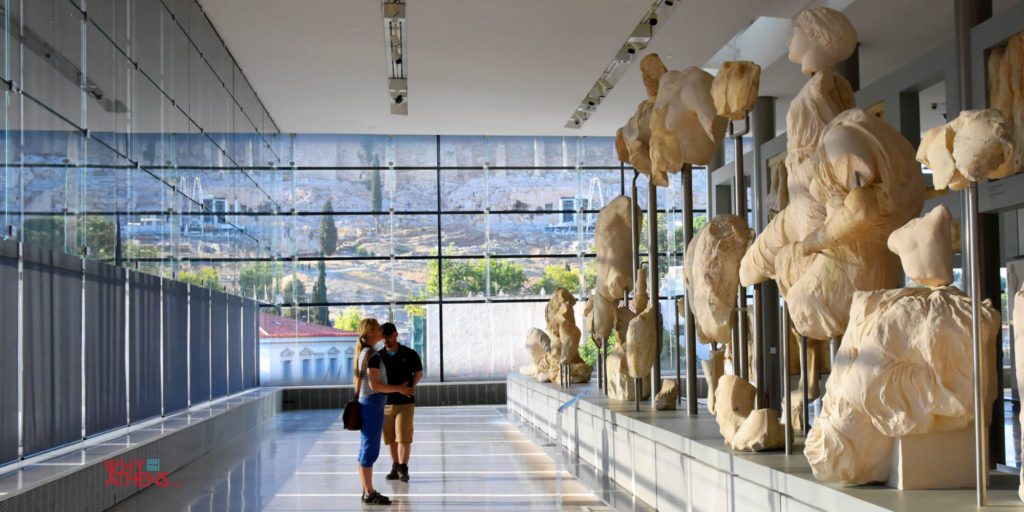
The west pediment featuring the mythological contest between Athena and Poseidon. Photograph: Why Athens | Acropolis Museum
The two pediments are the triangular areas formed by the sloping and horizontal corners of the roof. The east pediment was perched above the entrance of the temple depicting the supernatural birth of the goddess Athena who came out of the head of Zeus. The west depicts the mythological contest between Athena and Poseidon.
The Metopes
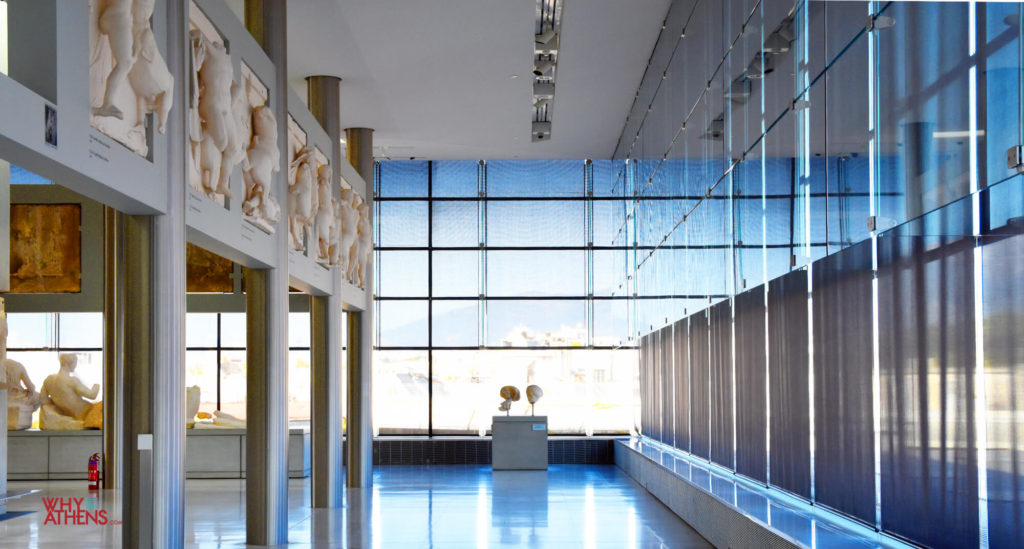
The museum displays the metopes as they appeared on the Parthenon. Photograph: Why Athens | Acropolis Museum
Follow the 92 relief panels or metopes that were once part of the external colonnades of the temple, they depict Greek mythology and legendary ancient battles. They are arranged above head height. The metope pictured below depicts a battle of a centaur versus man, which was one of the most recent panels to be removed from the Parthenon. It underwent careful cleaning and restoration and one of the few displayed at eye level in the gallery.
Skip the line e-tickets are available to purchase here in advance
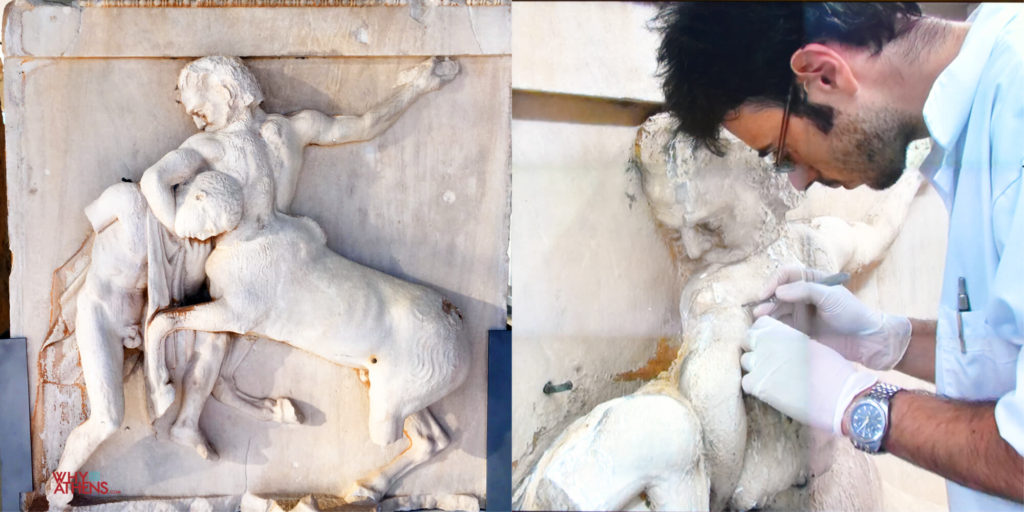
The delicate cleaning and restoration process of the Parthenon marbles. Photograph: Why Athens | Acropolis Museum
The Frieze
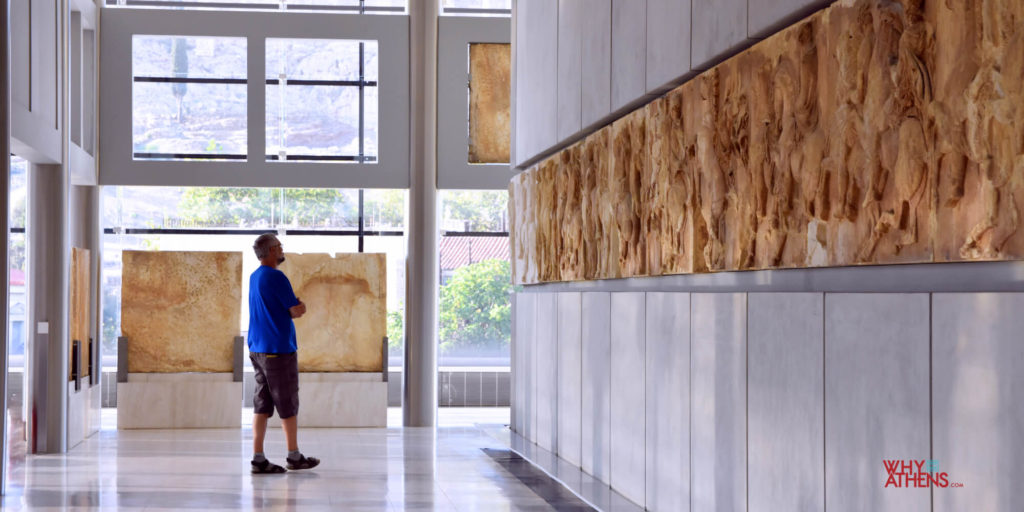
Originally placed on the inner wall of the Parthenon that protected the frieze from the elements. Photograph: Why Athens | Acropolis Museum
The most intricate element of the Parthenon was the frieze, which wrapped around the outer wall of the cella. Placed 12 metres high, it had a total length of 160 metres and is a continuous narrative carved in bas-relief, of the gods, humans, and animals that made up the Great Panathenaia that occurred every four years to honour the goddess Athena. The museum has done an impressive job of re-casting the missing elements of the story, with only 50 metres of the original. The remaining parts are scattered around the world with the majority (80 meters) in the British Museum, one block in the Louvre and other fragments scattered in the museums of Palermo, the Vatican, Würzburg, Vienna, Munich and Copenhagen.
The Parthenon Riders
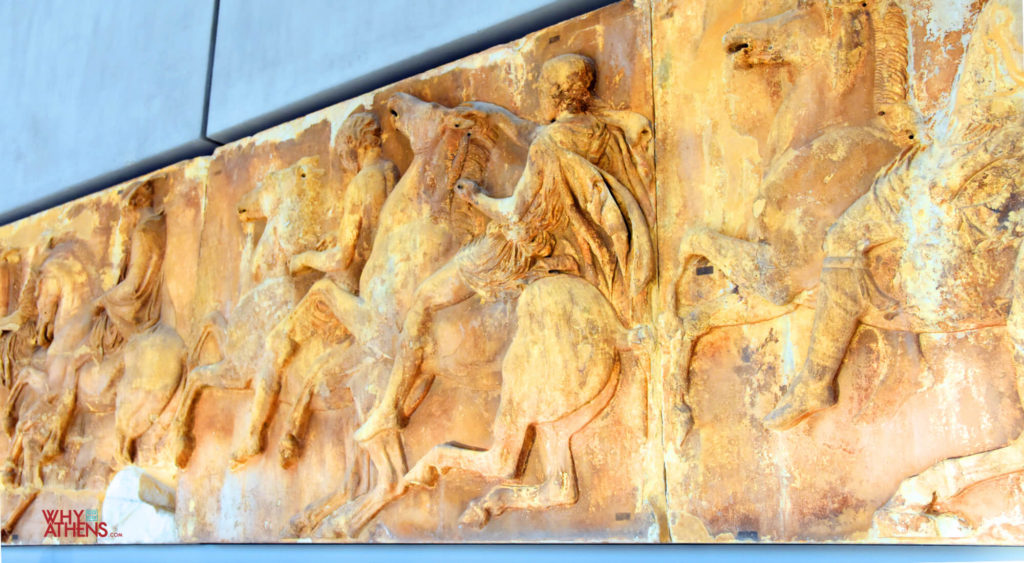
The Parthenon Riders, an important part of the sculpted narrative of the frieze. Photograph: Why Athens | Acropolis Museum
Many scholars pay particular attention to the west frieze that is believed to depict the ‘Parthenon Riders’, a group of horseman preparing for the Panathenaic procession. Look out for the one block with only one rider and one horse depicted, which is considered to be the actual work of Pheidias.
Exploring the rest of the Acropolis Museum
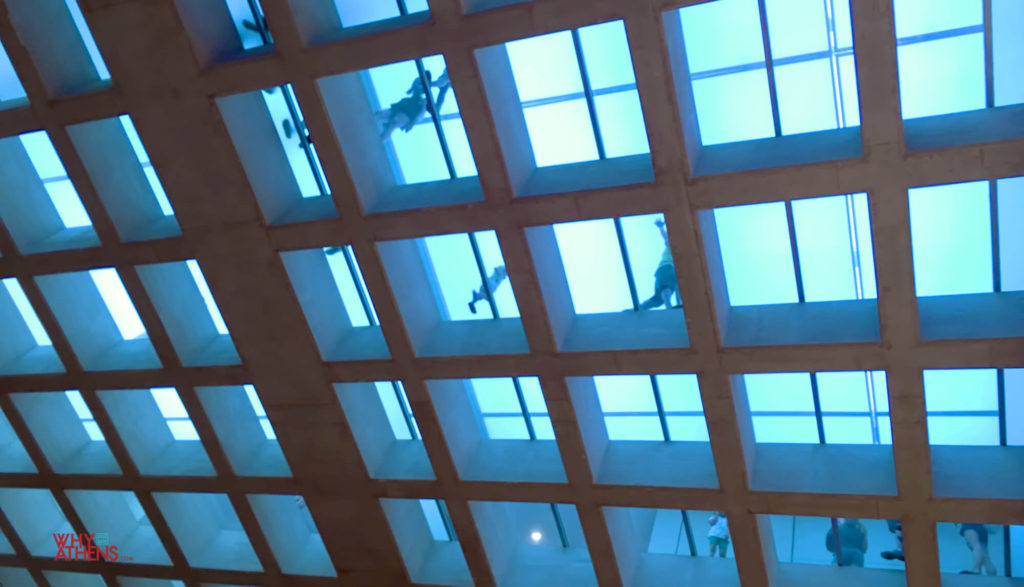
Transparent walkways from above and below allow your eyes to transcend space. Photograph: Why Athens | Acropolis Museum
Why Athens Tip: Having thoroughly explored the Parthenon Gallery, head down to the first floor to see the works created after the construction of the Parthenon, including the Propylaea, the Temple of Athena Nike and the Erechtheion.
The Caryatids

The famous Caryatids on the first floor with a noticeable gap for the sixth. Photograph: Why Athens | Acropolis Museum
On the first floor you will find five Caryatids, the original maidens that once held up the roof of the southern porch of the Erechtheion, considered the most sacred part of the Acropolis. They were removed in 1979 in order to protect them from the elements. Intricately detailed and hand-carved from Parian marble, each Caryatid is unique in their depiction and stand 7ft 7inches tall. A place remains vacant for the missing sixth Caryatid in the hope that someday she will rejoin her sisters. She is currently held in London at the British Museum.
The Hekatompedon
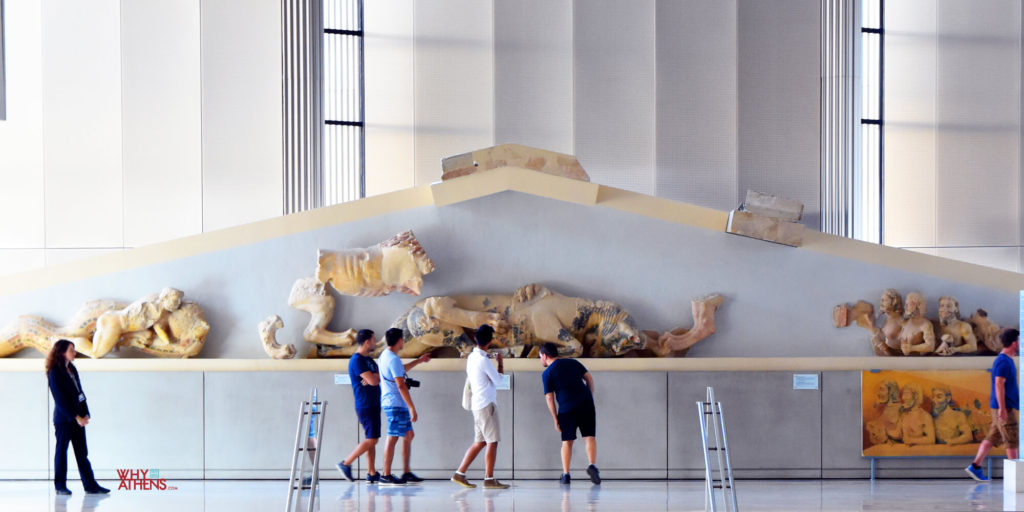
Pieces of a past Parthenon that existed during the archaic period. Photograph: Why Athens | Acropolis Museum
The permanent exhibition on level one includes remnants from the archaic period and in particular the enormous ‘poros’ pediment from the Parthenon at this time. Before Pericles erected the Parthenon as we know it today, two other temples pre-dated it. The Hekatompedon was the earliest known building on the Acropolis and was constructed from limestone in 570BC. Its name, literally meaning 100 feet in Greek, was inscribed on an ancient tablet found around the ancient site. The surviving elements on display depict Heracles wrestling a mythological beast, a lioness attacking a taurus, and a three bodied monster holdings objects representing the elements of water, wind and fire.
The Archaic Gallery
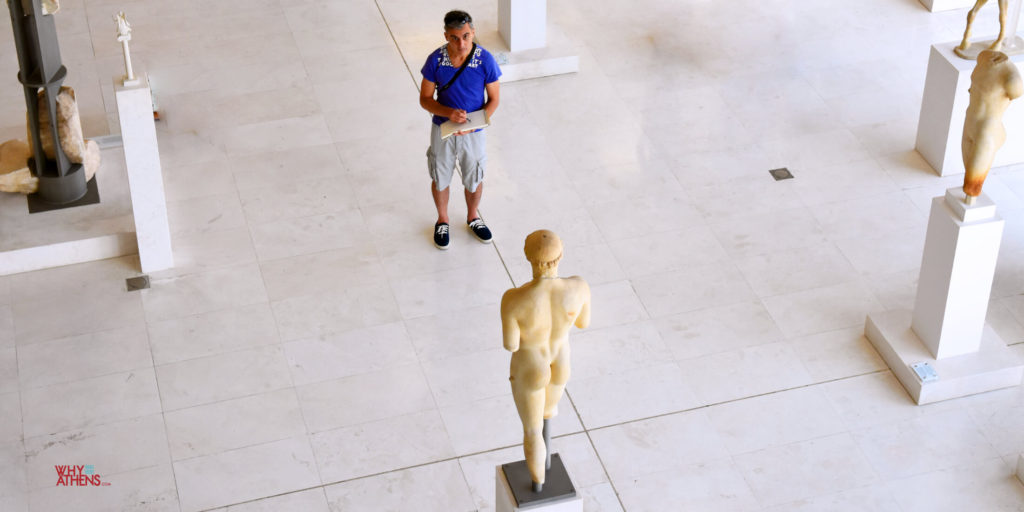
An artist’s paradise, the Archaic Gallery allows you to weave through the ancient statues to observe their intricate detail. Photograph: Why Athens | Acropolis Museum
The Archaic Gallery is a grand promenade of items from the 7th century BC when aristocracy prevailed through to 480BC with the establishment of democracy. The items are well preserved and thoughtfully displayed allowing you to gain a close-up view of their artistic quality. The gallery attracts artists who are often found with sketch pads, using the masculinity of Apollo to the sensual and stoic figures of Athena as their muse.
Gallery of the Slopes
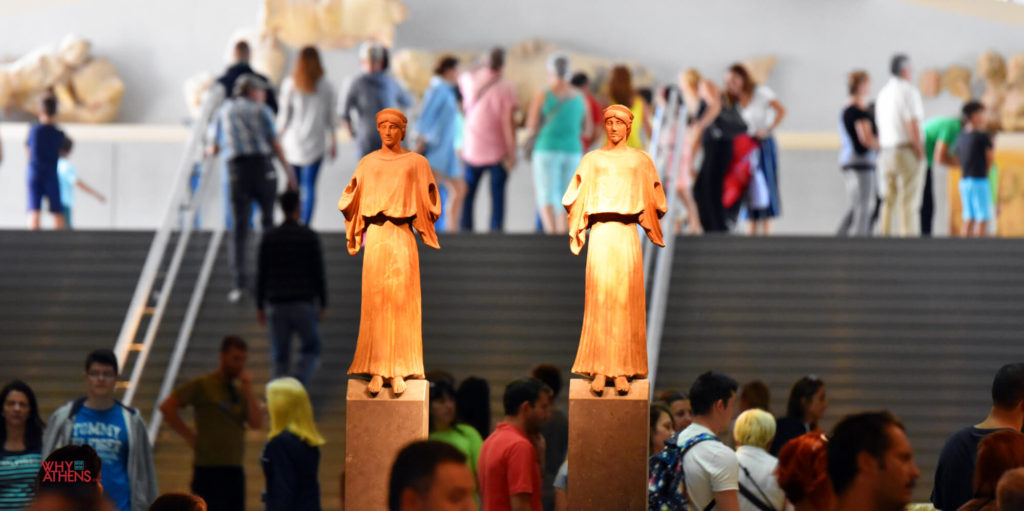
A pair of clay Nikes watch over the visiting crowds. Circa. 1-3rd century AD. Photograph: Why Athens | Acropolis Museum
In your last leg of your walk around the museum, choose to exit via the ‘slopes of the Acropolis’ where you will pass a pair of clay Nikes in immaculate condition, believed to have been decorations from a prominent roof or building from around the 1st-3rd century AD. The sloped areas take you on a journey through the ages of what life was like for the people who lived in the foothills of the sacred rock. A glass floor allows you to see another perspective of the archaeological excavation that was uncovered during the museum’s construction. The architects incorporated these slopes to represent the ascent or descent of climbing the Acropolis.
Excavation dig beneath the museum
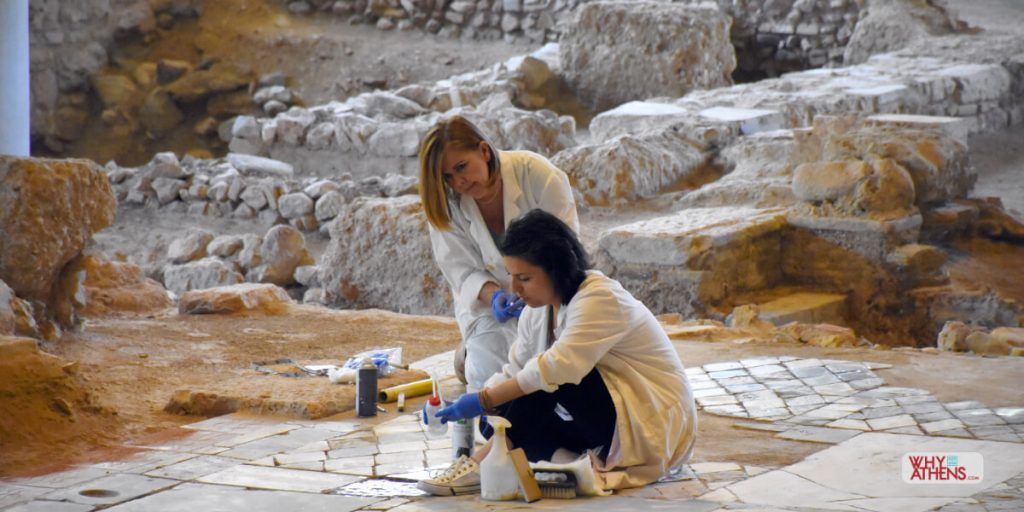
Restoration experts at the underfloor archaeological site at the Acropolis Museum. Photograph: Why Athens
An entire excavated neighbourhood that lies beneath the museum is now open to the public, providing a greater perspective of how the ancient Greeks once lived in Athens, from the classical to the byzantine years. Ancient villas, streets, baths and a sophisticated grid of plumbing are all visible across this settlement that spans 4,000 square metres, one of the largest within the boundaries of ancient Athens.
Why Athens Tips:
- Skip the line e-tickets are available to purchase in advance here
- Museum archaeologist hosts are available to answer questions about the exhibits every day from 9:30am – 5:00pm. You’ll find them wearing large red and white badges. (Available in English, French and Greek).
- The museum offers a complimentary guided tour at various times throughout the year, with the price of normal admission, every Friday at 6:00pm led by an archaeologist who shares fascinating insights about the exhibits. Check the museum’s website for active tours.
- The museum by night is magical and remains open until 10:00pm on Fridays.
- The Acropolis Museum restaurant is open from 8:00am (9:00am in winter) with indoor and outdoor seating and views of the Parthenon. Coffee, breakfast and lunch is served seven days a week and dinner is served until 10:00pm on Fridays. A ground floor café is also available overlooking the archaeological excavation
- SEE WHAT SPECIAL EVENTS ARE ON THIS MONTH AT THE MUSEUM
Read about the best vantage spots to photograph the Acropolis.


